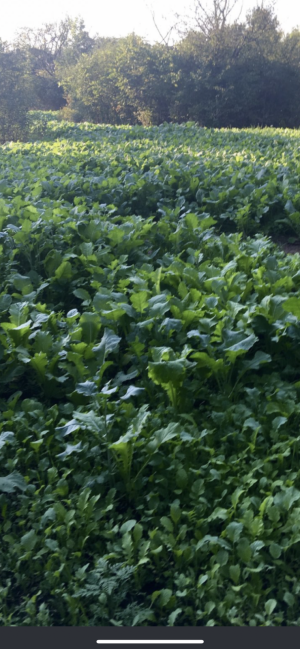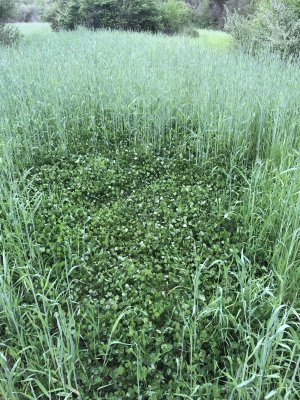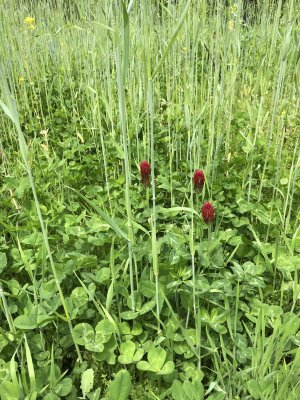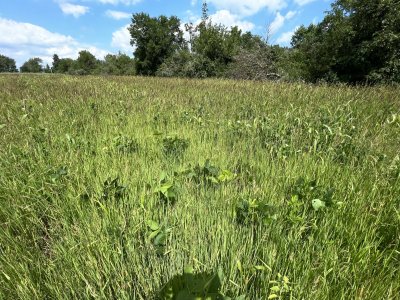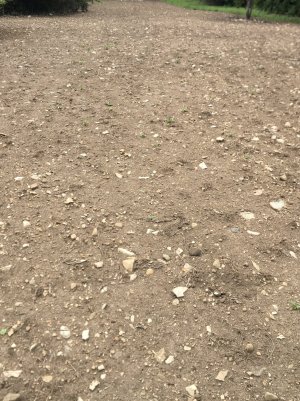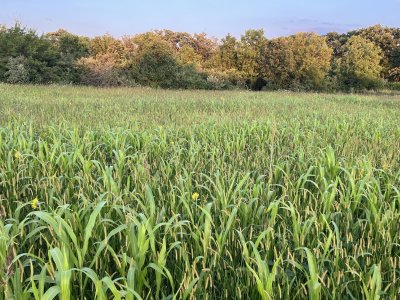Rit
5 year old buck +
**disclaimer** my frustration level is at an all time high!
I am big soil health guy and do believe soil disturbance destroys soil…..but all my best plots have been put in with a 5’ tiller or a modified TNM. I have two types of soil on my little hobby farm. Heavy heavy clay and a rocky mess with soil on the lighter side. If I am being honest with myself I have never had anything better than an okay plot in the big destination plot which consist of heavy heavy clay that was a hayfield for 8+ years. I leased it out to a guy who wasn’t a super motivated farmer type who ran a small hobby farm himself. In the years he leased the field he never once put fertilizer down but continued to harvest the hay off of it. When I took it over in 2018 I did a soil test and amended it accordingly but have not used fertilizer since. I’d say it’s compacted. I have tried mightily to break up the compaction with roots. It’s better but not quite right. Water infiltration isn’t very good either.
My no-till story began somewhere around 2017 soon after I found this site. I started with TNM style plot using a hand sprayer, ATV, and a pull behind rough cut trail mower. Before that I used to pay someone to till up my plots. Later on I would purchase a tractor, rotary cutter and in 2020 I purchased a no-till drill and progressively my plots have gotten worse each year. Especially in my main field which is heavy heavy clay.
Whatever I have tried with the no-till just flat out is not working. I recently planted half of 3 plots with varying methods. The drill itself works fine and puts the seed where I want it.
All 3 plots I broadcast winter rye into the standing vegetation before drilling. A little early but we had 4 days of rain in the forecast I couldn’t pass up.
Plot 1 - I drilled into the failed summer plot and walked away.
Plot 2 - I drilled into the field and used my rotary cutter to cut down about half of the above ground growth. It consisted of soybeans, sorghums, cowpeas, sunflower, buckwheat, sunn hemp, and a half dozen other seeds but also had foxtail, millets, and Johnson grass.
Plot 3 - drilled into the standing vegetation cut 3/4 of the vegetation and then immediately sprayed. We all know why this isn’t the greatest strategy but I was trying something different because as mentioned what I have been doing isn’t working. There was quite a bit of broadleaf pressure under the canopy below where I mowed so I figured I would at least kill off that competition.
I would probably still be using TNM but the problem with it for my situation is that my 72” Landpride Rotary cutter windrows the above ground vegetation terribly and creates these thick matted rows that new growth does not penetrate while allowing un-killed vegetation to recover. They hold moisture and eventually mold. Even cutting against the grain or perpendicular doesn’t yield perfect results. On top of that these windrows appear to line up with my tractor tires and when I go back to spray nothing under these rows gets killed and the vegetation can and will stand back up.
I have great cover and the biggest problem with my property is fall food. In good acorn years I have deer thick until they run out. I have loads of mature oaks but unfortunately they are Chinkapin oaks and around here they start dropping mid September and by mid October they are consumed and with it my hunting opportunities.
The bucks I have killed here have either been killed really early like first week of season or in years where we have had absolutely perfect rain I have killed them during early November because my plots are above average. Mind you I am surrounded by thousands of acres of Ag and no one plants plots. If anything they dump corn on the ground.
This has me pondering my next steps. Sell the farm for better soils? Change my no-till mentality and start tilling? Take up knitting? I have 3 halves of the plots to plant but just waiting for a solid rain event. All 3 plots currently still have standing vegetation. I may mow them down today because drilling into them standing and the eventual windrows isn’t working out very well. I have been considering either purchasing a tiller or renting one and putting them in that way. I sold off my disk, drag, and cultipacker because I had plans to be the no-till king.
I have plenty of seed on hand. GC’s fall release, bushels of WR, plus some sunflowers, beans, peas, radishes, and clover.
In an hour I am going to look at Dunham Lehr 8. Great price and it looks very usable. I had plans of purchasing a roller crimper in the spring but I’m not sure that’s the route I will take anymore. If I can get great plots with a tiller I am ready to give soil health a backseat. I am not sure how to proceed here. Thoughts?
I am big soil health guy and do believe soil disturbance destroys soil…..but all my best plots have been put in with a 5’ tiller or a modified TNM. I have two types of soil on my little hobby farm. Heavy heavy clay and a rocky mess with soil on the lighter side. If I am being honest with myself I have never had anything better than an okay plot in the big destination plot which consist of heavy heavy clay that was a hayfield for 8+ years. I leased it out to a guy who wasn’t a super motivated farmer type who ran a small hobby farm himself. In the years he leased the field he never once put fertilizer down but continued to harvest the hay off of it. When I took it over in 2018 I did a soil test and amended it accordingly but have not used fertilizer since. I’d say it’s compacted. I have tried mightily to break up the compaction with roots. It’s better but not quite right. Water infiltration isn’t very good either.
My no-till story began somewhere around 2017 soon after I found this site. I started with TNM style plot using a hand sprayer, ATV, and a pull behind rough cut trail mower. Before that I used to pay someone to till up my plots. Later on I would purchase a tractor, rotary cutter and in 2020 I purchased a no-till drill and progressively my plots have gotten worse each year. Especially in my main field which is heavy heavy clay.
Whatever I have tried with the no-till just flat out is not working. I recently planted half of 3 plots with varying methods. The drill itself works fine and puts the seed where I want it.
All 3 plots I broadcast winter rye into the standing vegetation before drilling. A little early but we had 4 days of rain in the forecast I couldn’t pass up.
Plot 1 - I drilled into the failed summer plot and walked away.
Plot 2 - I drilled into the field and used my rotary cutter to cut down about half of the above ground growth. It consisted of soybeans, sorghums, cowpeas, sunflower, buckwheat, sunn hemp, and a half dozen other seeds but also had foxtail, millets, and Johnson grass.
Plot 3 - drilled into the standing vegetation cut 3/4 of the vegetation and then immediately sprayed. We all know why this isn’t the greatest strategy but I was trying something different because as mentioned what I have been doing isn’t working. There was quite a bit of broadleaf pressure under the canopy below where I mowed so I figured I would at least kill off that competition.
I would probably still be using TNM but the problem with it for my situation is that my 72” Landpride Rotary cutter windrows the above ground vegetation terribly and creates these thick matted rows that new growth does not penetrate while allowing un-killed vegetation to recover. They hold moisture and eventually mold. Even cutting against the grain or perpendicular doesn’t yield perfect results. On top of that these windrows appear to line up with my tractor tires and when I go back to spray nothing under these rows gets killed and the vegetation can and will stand back up.
I have great cover and the biggest problem with my property is fall food. In good acorn years I have deer thick until they run out. I have loads of mature oaks but unfortunately they are Chinkapin oaks and around here they start dropping mid September and by mid October they are consumed and with it my hunting opportunities.
The bucks I have killed here have either been killed really early like first week of season or in years where we have had absolutely perfect rain I have killed them during early November because my plots are above average. Mind you I am surrounded by thousands of acres of Ag and no one plants plots. If anything they dump corn on the ground.
This has me pondering my next steps. Sell the farm for better soils? Change my no-till mentality and start tilling? Take up knitting? I have 3 halves of the plots to plant but just waiting for a solid rain event. All 3 plots currently still have standing vegetation. I may mow them down today because drilling into them standing and the eventual windrows isn’t working out very well. I have been considering either purchasing a tiller or renting one and putting them in that way. I sold off my disk, drag, and cultipacker because I had plans to be the no-till king.
I have plenty of seed on hand. GC’s fall release, bushels of WR, plus some sunflowers, beans, peas, radishes, and clover.
In an hour I am going to look at Dunham Lehr 8. Great price and it looks very usable. I had plans of purchasing a roller crimper in the spring but I’m not sure that’s the route I will take anymore. If I can get great plots with a tiller I am ready to give soil health a backseat. I am not sure how to proceed here. Thoughts?


